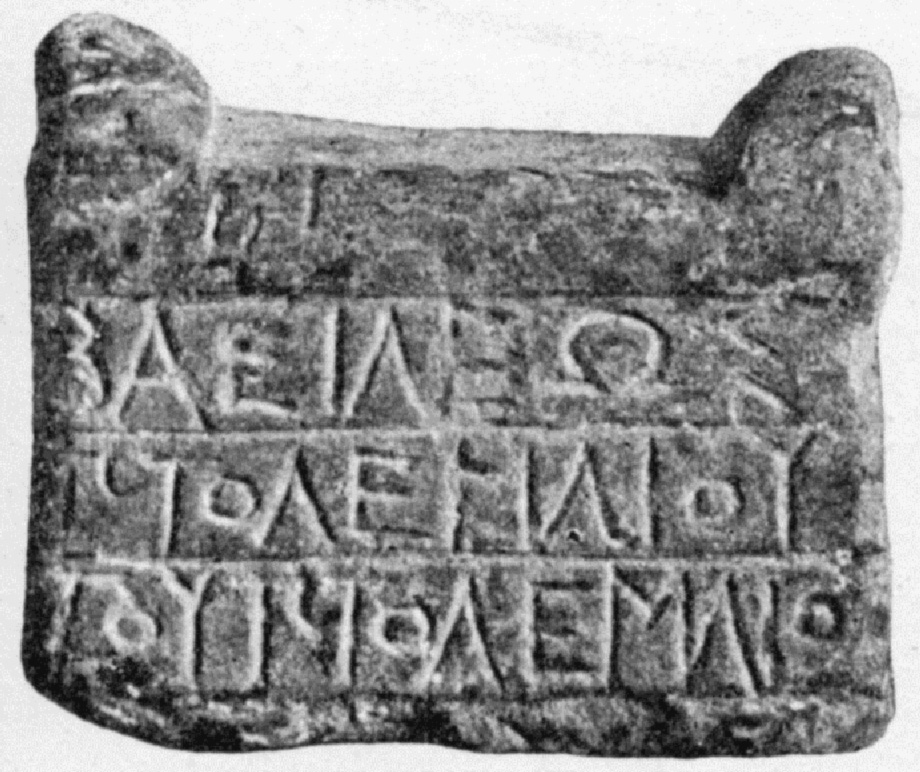
PHRC051 : Dedication to King Ptolemy II and Arsinoe Philadelphos, Alexandria - Egypt (270-246 BC) Dedication
Permanent ID http://s.phrc.it/phrc051
Images
Photos 1-2: photos of the altar, from Schreiber 2011, Tf. 53, Figg. 4-5

Text constituted from: I.Alex.Ptol. 7 (from which our edition differs for the last Y on face A, line 3).
Other editions: Botti 1902, p. 103, no. 96 (misinterpreting the object as a miniature sarcophagus); CPI I 33.
See also: Caneva 2013, p. 294; Caneva 2014a, no. 1; Caneva 2016a, p. 156.
Images: Schreiber 2011, Tf. 53, nos. 4-5; CPI I 33, p. 90, Fig. 19.
Further bibliography: on 'horned' altars with akroteria in Ptolemaic Egypt, see Burr Thompson 1973, 35-39, 59-61; Soukiassian 1983; Quaegebeur 1993. On the burning of incense in Hellenistic ruler cults, Caneva 2022 (forthcoming).
Online record: TM 107253
This small incense burner, carved in the shape of a miniature horned altar, is very similar to our PHRC 059, also probably from Alexandria. Horned altars are often depicted on Alexandrian oinochoai and on Egyptian stelae representing scenes of Ptolemaic ruler cults (Burr Thompson 1973, 35-39, 59-61; Caneva 2013, 294, 303-304, 315). This incense burner was dedicated by unnamed priests. The identity of the deity they worshiped is not given in the inscription. This may imply that they consecrated this object on the place where they carried out their function. The hypothesis that the donors specifically served as officiants of the royal cult cannot be rejected beyond any doubt, if we assume that the plural refers to the priest of the Theoi Adelphoi and the kanephoros of Arsinoe Philadelphos. However, this grouping is not paralleled by our evidence from 3rd-cent. Alexandria. It is therefore more plausible that the priests served other cults, in which case the ruling couple may have received joint honours as synnaoi theoi (for a dedication to sovereigns by priests of another deity, see PHRC 053 from Alexandria). The dedicatory formula mentioning ‘King Ptolemy and Arsinoe Philadelphos’ is common between the death of Arsinoe in 270 and Ptolemy’s death in 246, when it evoked the couple as still ritually and symbolically unified despite the queen’s passing (cf. commentary to PHRC 005). This same formula is also attested on a larger altar found under Ptolemy III’s Serapeum in Rhakotis (PHRC 052).
Small altars bearing a dedication in the genitive are often linked to the household cult for Arsinoe Philadelphos during the Alexandrian procession quoted by Satyros (P.Oxy. XXVII 2465, cf. Schorn 2001 and Caneva 2014a, p. 93-94). However, the type of donors involved in this case speaks against the hypothesis of a domestic use. Stähler 1980, p. 50, followed by Schreiber 2011, p. 198-199, argued that this type of altar could be used as a portable tool to pour libations or to burn vegetable offerings while travelling. Following this explanation, the fact that the altar was found in the area of the ancient Alexandrian harbour might point to the possibility that, after being used during a sea journey, the altar was consecrated to Arsinoe in the sanctuary of the Arsinoeion, thus fulfilling a vow for a successful trip. However, while an original location in the Arsinoeion is possible, we should observe that the hypothesis of a vow for a successful sea journey would require an individual donor. The most plausible interpretation is that this small object was used by some priests to burn incense to the couple of the living Ptolemy II and the dead and deified Arsinoe. The presence of writing guidelines and the ‘Egyptian’ style of the script (for these details, Crowther 2020, 234, 241, 243) may point to a dedication made by indigenous priests living in Alexandria, or perhaps honouring the royal couple during a visit to the capital. In this case, the lack of information about the priests’ charges could be explained because the donors dedicated the object collectively on a specific occasion, regardless of the deity they served on a regular basis.



